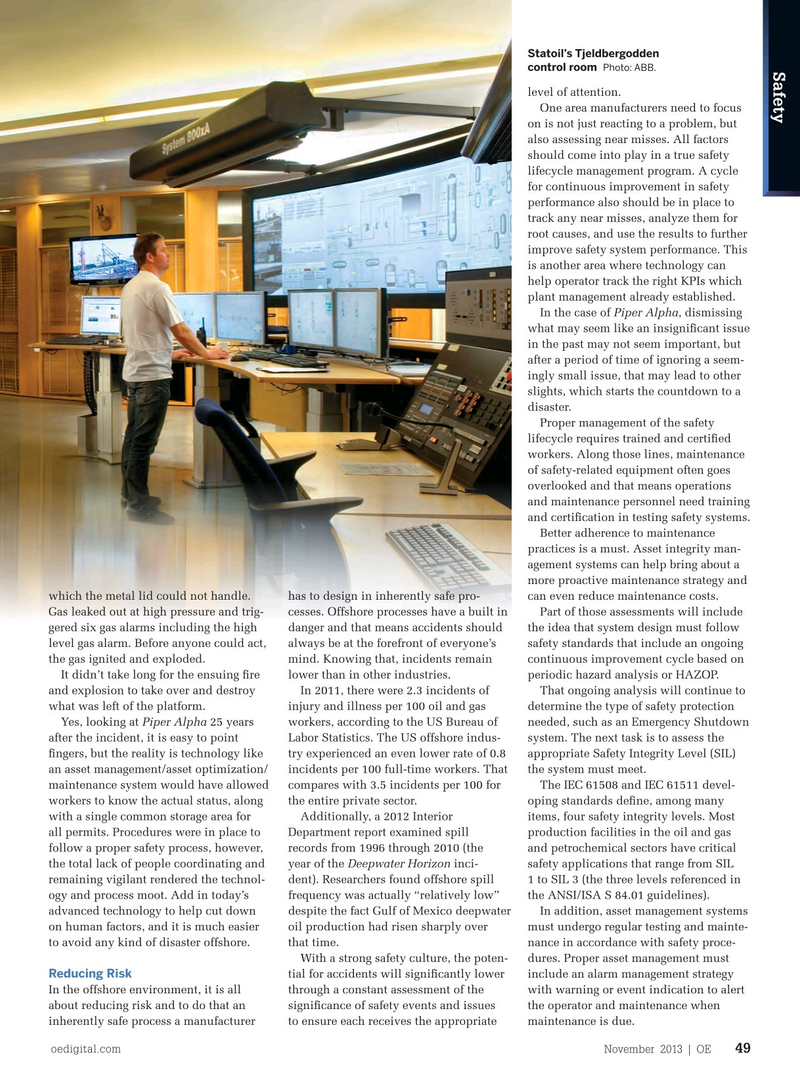
Page 47: of Offshore Engineer Magazine (Nov/Dec 2013)
Read this page in Pdf, Flash or Html5 edition of Nov/Dec 2013 Offshore Engineer Magazine
Statoil’s Tjeldbergodden control room Photo: ABB.
Safety level of attention.
One area manufacturers need to focus on is not just reacting to a problem, but also assessing near misses. All factors should come into play in a true safety lifecycle management program. A cycle for continuous improvement in safety performance also should be in place to track any near misses, analyze them for root causes, and use the results to further improve safety system performance. This is another area where technology can help operator track the right KPIs which plant management already established.
In the case of Piper Alpha, dismissing what may seem like an insignifcant issue in the past may not seem important, but after a period of time of ignoring a seem- ingly small issue, that may lead to other slights, which starts the countdown to a disaster.
Proper management of the safety lifecycle requires trained and certifed workers. Along those lines, maintenance of safety-related equipment often goes overlooked and that means operations and maintenance personnel need training and certifcation in testing safety systems.
Better adherence to maintenance practices is a must. Asset integrity man- agement systems can help bring about a more proactive maintenance strategy and which the metal lid could not handle. has to design in inherently safe pro- can even reduce maintenance costs.
Gas leaked out at high pressure and trig- cesses. Offshore processes have a built in Part of those assessments will include gered six gas alarms including the high danger and that means accidents should the idea that system design must follow level gas alarm. Before anyone could act, always be at the forefront of everyone’s safety standards that include an ongoing the gas ignited and exploded. mind. Knowing that, incidents remain continuous improvement cycle based on
It didn’t take long for the ensuing fre lower than in other industries. periodic hazard analysis or HAZOP. and explosion to take over and destroy In 2011, there were 2.3 incidents of That ongoing analysis will continue to what was left of the platform. injury and illness per 100 oil and gas determine the type of safety protection
Yes, looking at Piper Alpha 25 years workers, according to the US Bureau of needed, such as an Emergency Shutdown after the incident, it is easy to point Labor Statistics. The US offshore indus- system. The next task is to assess the fngers, but the reality is technology like try experienced an even lower rate of 0.8 appropriate Safety Integrity Level (SIL) an asset management/asset optimization/ incidents per 100 full-time workers. That the system must meet.
maintenance system would have allowed compares with 3.5 incidents per 100 for The IEC 61508 and IEC 61511 devel- workers to know the actual status, along the entire private sector. oping standards defne, among many with a single common storage area for Additionally, a 2012 Interior items, four safety integrity levels. Most all permits. Procedures were in place to Department report examined spill production facilities in the oil and gas follow a proper safety process, however, records from 1996 through 2010 (the and petrochemical sectors have critical the total lack of people coordinating and year of the Deepwater Horizon inci- safety applications that range from SIL remaining vigilant rendered the technol- dent). Researchers found offshore spill 1 to SIL 3 (the three levels referenced in ogy and process moot. Add in today’s frequency was actually “relatively low” the ANSI/ISA S 84.01 guidelines).
advanced technology to help cut down despite the fact Gulf of Mexico deepwater In addition, asset management systems on human factors, and it is much easier oil production had risen sharply over must undergo regular testing and mainte- to avoid any kind of disaster offshore. that time. nance in accordance with safety proce-
With a strong safety culture, the poten- dures. Proper asset management must
Reducing Risk tial for accidents will signifcantly lower include an alarm management strategy
In the offshore environment, it is all through a constant assessment of the with warning or event indication to alert about reducing risk and to do that an signifcance of safety events and issues the operator and maintenance when inherently safe process a manufacturer to ensure each receives the appropriate maintenance is due. oedigital.com November 2013 | OE 49 048_OE1113_ABB Safety.indd 49 10/28/13 1:56 AM

 46
46

 48
48